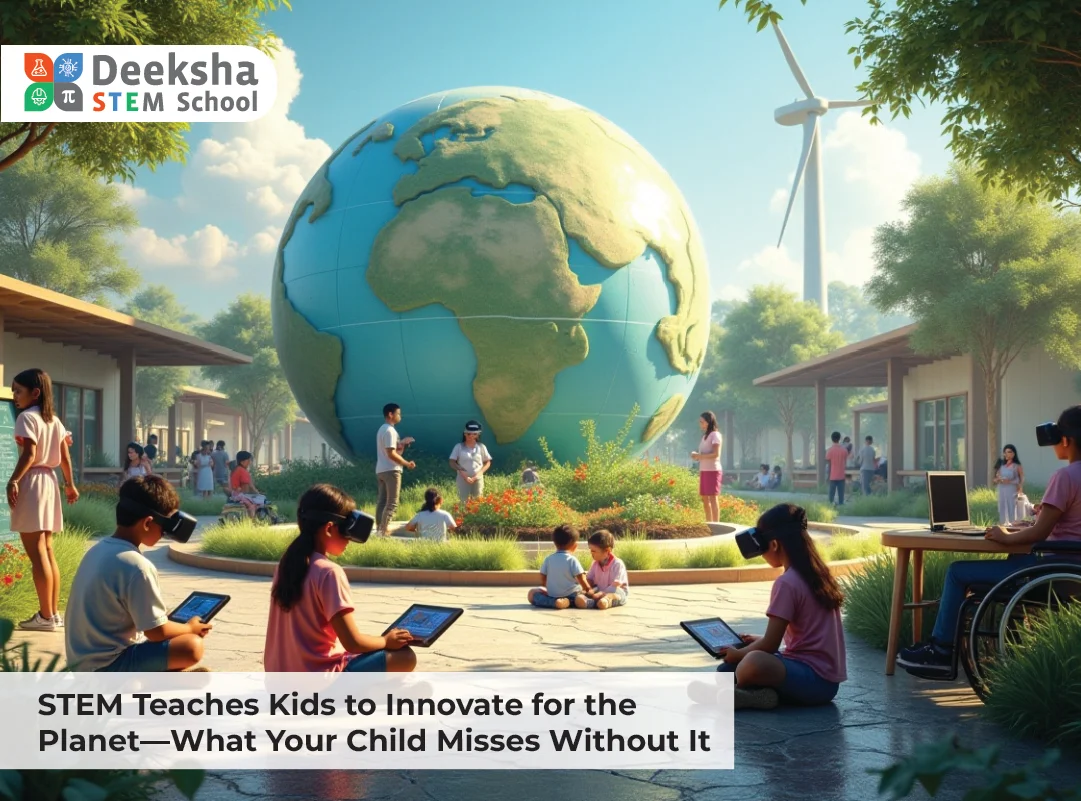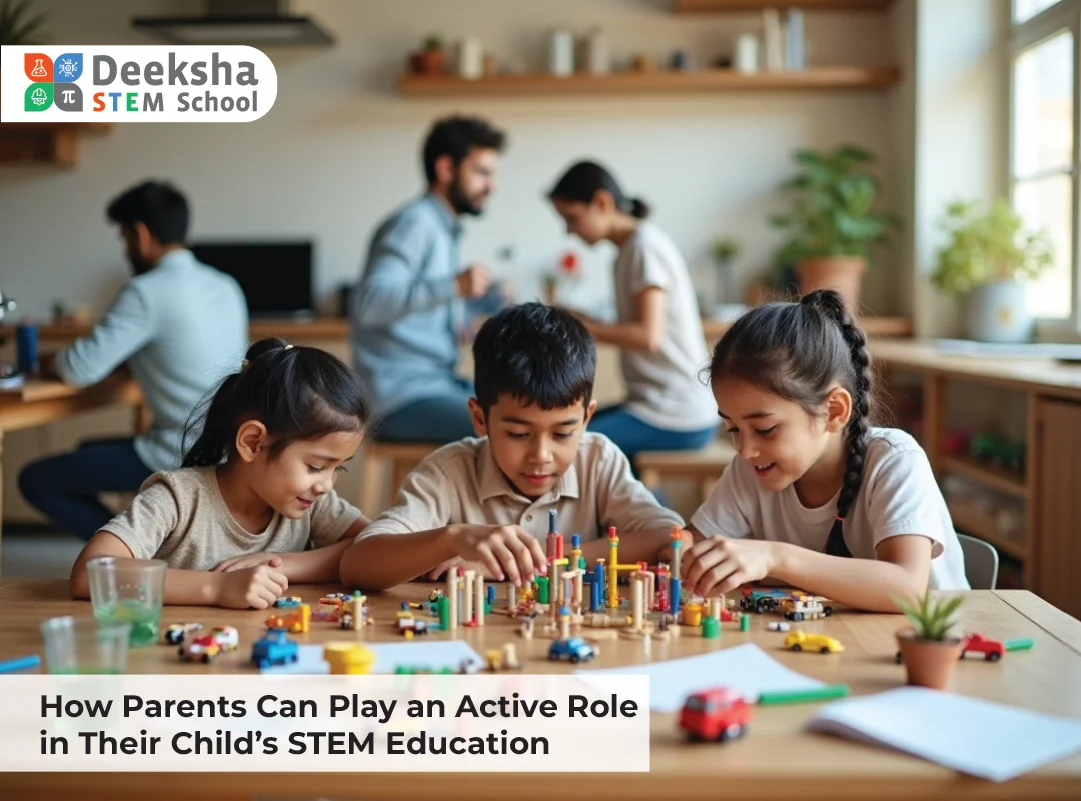STEM Teaches Kids to Innovate for the Planet—What Your Child Misses Without It

Introduction: The Role of STEM in Saving the Planet
The challenges our planet faces today—climate change, deforestation, plastic pollution, and dwindling natural resources—demand urgent action. Addressing these issues requires creative minds equipped with the skills and knowledge to innovate sustainable solutions. This is where STEM (Science, Technology, Engineering, and Mathematics) plays a pivotal role.
Early exposure to STEM concepts fosters eco-consciousness in children. It teaches them to observe environmental problems critically, think innovatively, and act responsibly. By integrating STEM into their learning journey, children can explore the tools and techniques to combat environmental challenges effectively.
- At Deeksha STEM:
Deeksha STEM’s programs are designed to inspire environmental stewardship among students. Through hands-on projects and real-world applications, children not only learn about sustainability but also practice it by creating impactful solutions.
STEM Encourages Awareness of Environmental Issues
Awareness is the first step toward change. STEM introduces children to pressing environmental topics, such as climate change, pollution, renewable energy, and biodiversity conservation. By understanding these issues, children gain a sense of responsibility and a desire to contribute to solutions.
- Key Points:
- STEM makes abstract environmental concepts tangible through experiments, data collection, and simulations.
- Activities like testing water purity or analyzing air quality help children see the immediate impact of environmental issues.
- Example:
Students might collect soil samples from their neighborhood and test their nutrient levels. They can then compare the results to ideal soil conditions and brainstorm ways to improve soil health, such as composting or crop rotation. - At Deeksha STEM:
Deeksha STEM integrates environmental topics into its curriculum. For instance, students might explore the effects of deforestation by analyzing changes in temperature and rainfall data. They’re encouraged to think critically about solutions, such as reforestation or urban green initiatives.
STEM Fosters Problem-Solving for Real-World Challenges
Environmental issues often require innovative problem-solving. STEM teaches students how to approach these problems methodically, analyze root causes, and design effective solutions.
- Key Points:
- STEM projects encourage critical thinking and iterative design.
- Students learn to adapt their solutions based on real-world constraints like budget, materials, and practicality.
- Example:
A project could involve designing a drip irrigation system to conserve water in agriculture. Students would research water-saving techniques, prototype their designs, and refine them based on testing. - At Deeksha STEM:
Students participate in projects like creating waste segregation systems for schools or building models to optimize renewable energy usage in homes. These exercises teach them to connect theoretical knowledge with practical applications.
STEM Encourages Sustainable Innovation
STEM goes beyond identifying problems; it empowers children to innovate solutions that have a lasting impact. Sustainable innovation means designing systems, products, or technologies that improve quality of life while protecting the environment.
- Key Points:
- Creativity in STEM enables children to think of unconventional solutions to global challenges.
- By combining science, technology, and design, students can develop eco-friendly alternatives to everyday practices.
- Example:
Students could work on designing biodegradable packaging to reduce plastic waste. This might involve researching materials like plant-based polymers and creating prototypes for practical use. - At Deeksha STEM:
Deeksha STEM encourages sustainable innovation through interdisciplinary projects. For example, students might design a solar-powered device for rural areas, blending engineering with environmental science to solve real-world problems.
STEM Prepares Kids for Green Careers
Green careers—roles focused on sustainability and environmental conservation—are on the rise. Early exposure to STEM concepts prepares children to excel in these fields by equipping them with the necessary knowledge and skills.
- Key Points:
- Careers in renewable energy, environmental engineering, and sustainable architecture rely heavily on STEM expertise.
- By fostering an interest in these areas early on, STEM education creates a strong foundation for future success.
- Example:
A student exposed to renewable energy projects in school may pursue a career as a solar energy engineer or develop smart grid technologies to improve energy efficiency. - At Deeksha STEM:
The curriculum introduces students to green career possibilities, such as creating smart waste management systems or developing renewable energy technologies. These projects demonstrate how STEM skills can be applied to build a sustainable future.
What Your Child Misses Without STEM
Children without STEM exposure miss out on opportunities to develop critical skills, explore real-world problems, and create impactful solutions. They may lack awareness of global challenges or the confidence to address them.
- Key Points:
- Without STEM, children miss the chance to build problem-solving skills essential for tackling environmental challenges.
- They may not develop the creativity and technical knowledge needed to innovate sustainably.
- Comparison Table:
| With STEM | Without STEM |
| Awareness of global environmental issues | Limited understanding of key challenges |
| Practical problem-solving skills | Theoretical knowledge with little application |
| Confidence to innovate and experiment | Hesitation to try new ideas |
| Exposure to green career opportunities | Limited awareness of sustainable careers |
How Deeksha STEM Nurtures Innovators for the Planet
At Deeksha STEM, sustainability is a core focus of the learning process. Students are encouraged to explore environmental issues, brainstorm solutions, and implement their ideas through collaborative projects.
- Key Points:
- A hands-on approach ensures students learn by doing, making the connection between academic concepts and real-world impact.
- Interdisciplinary projects help students integrate knowledge from various fields to create holistic solutions.
- Example:
Students might work on a project to design an energy-efficient home. This could involve using solar panels, rainwater harvesting systems, and smart appliances to minimize environmental impact.
Parents are encouraged to explore Deeksha STEM’s programs to provide their children with the tools, knowledge, and mindset needed to innovate for the planet.
Conclusion: Empowering the Next Generation of Environmental Leaders
STEM education is more than academic training; it’s a gateway to creating a sustainable future. By teaching children to innovate for the planet, STEM empowers them to make a tangible difference. Early exposure to STEM fosters skills like critical thinking, creativity, and collaboration, preparing children to tackle global challenges head-on.
At Deeksha STEM, we are committed to nurturing a generation of eco-conscious innovators. By combining practical projects with a focus on sustainability, we ensure that every child has the opportunity to shape a greener future.
Empower your child to lead the way in environmental innovation. Enroll in Deeksha STEM today and take the first step toward a brighter, more sustainable tomorrow.




